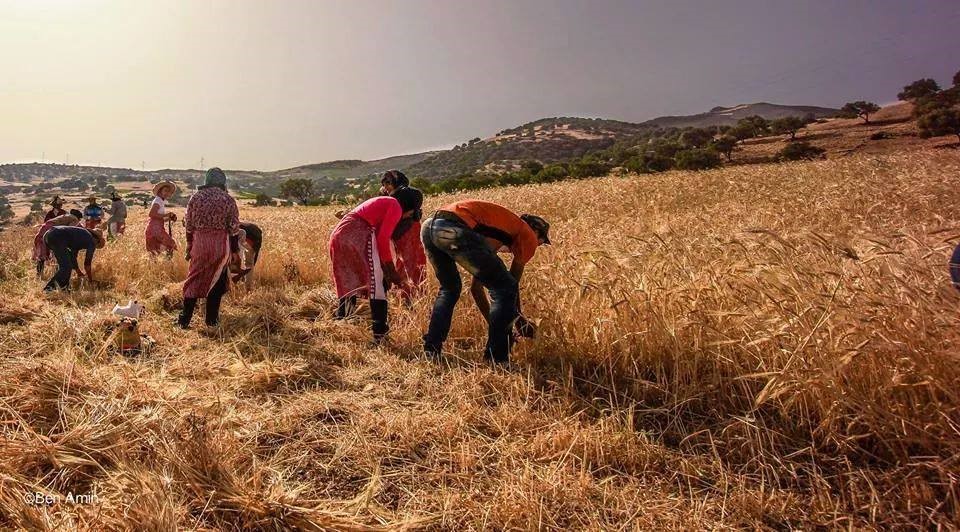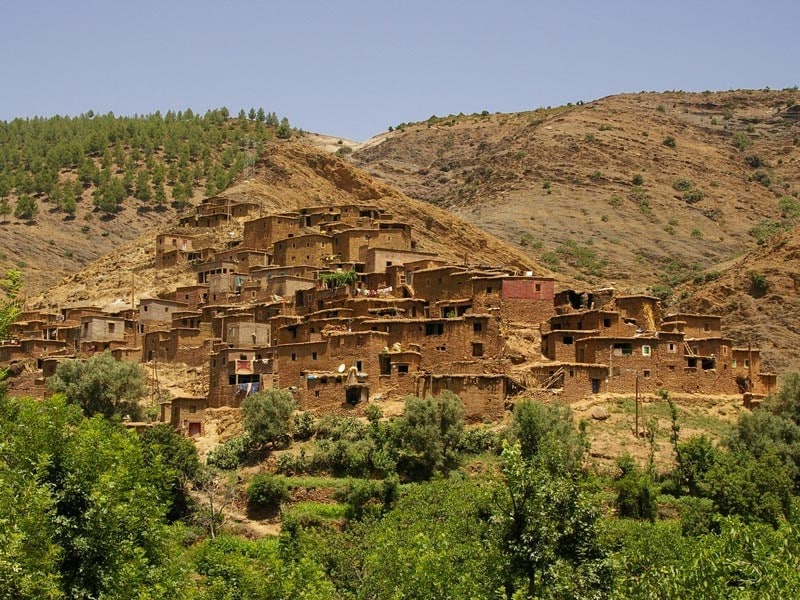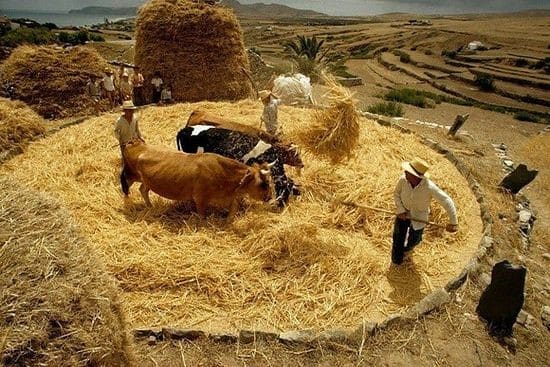[dropcap]I[/dropcap]n March 2004, activists from Ait Mrghad sought to block the transfer of five hectares of uncultivated Amazigh land to the local government. The government argued that the project would benefit the public good by attracting tourism and generating local jobs. The activists declared, “Our identity is our language and our land.” The recent battle in Ait Mrghad between the Amazigh and the central government not only demonstrates the importance of land to Amazigh identity, but also represents the role land tenure has played throughout Amazigh history.
[ads1]
Importance of land among the Imazighen
Though the modern Amazigh renaissance has centered on language, territorial integrity has emerged as a critical aspect of cultural and lingual preservation. Customary land ownership and management practices, however, have always been contested by central authorities throughout history. Bruce Maddy Weitzman notes in The Berber Identity Movement,
“In Morocco, the authorities, whether French or Moroccan, are depicted as running roughshod over Amazigh communal rights and tradition.”
This paper will examine how Amazigh land ownership and management have been impacted by Roman imperialism, Arab-Islamic acculturation, French colonialism, and modern politics. Subjugation to an imported social and political power has exacerbated tensions between the central authority and the Imazighen in the past and present; however, many customary rights and beliefs are still widely acknowledged and observed by Amazigh communities today.
Land tenure or tamazirt is often referred to as al-asl— origin and ancestry— because of its spiritual and economic importance. For most Imazighen, land tenure represents “the founding pillar of law and tradition, azarf.” Land ownership in Amazigh society deals with communal, tribal, and familial rights—most of which have been entrenched for generations. Customary law defines land as a communally-owned good distributed among members of a tribal unit. According to Pedro Fiz Rocha Correa:
“Traditionally among nomads, land is not commercially transacted and is property of the tribe, while tents and animals are recognized as private property.”
[ads1]
Customary procedure for assigning land involves the zouja, which divides land based on the terrain rather than by fixed area size. A zouja indicates the amount of terrain that can be cultivated by a span of draft animals, while a zorija is a living unit of roughly 30 to 40 acres. Although the Imazighen do not believe in the transaction of land, the rights to manage a given parcel of land can be used as collateral in exchange for a monetary loan.
This pledging of land is referred to as rahn, “a loan of land in exchange for allowing usufruct rights for a money loan over a determined period of time.” Amazigh customs also dictate that land should not be divided. Hsain Ilahiane observed that the land tenure code of Ait Atta, as reported in their oral tradition and written documents, prohibited the fragmentation of land and denied individuals outside of the tribal unit the rights to use land.

Families retain the rights to use land within the tribal parcel of land since usage rights are inherited. It is difficult to determine whether land was inherited through the patrilineal or matrilineal line prior to the arrival of shari’a law. Most evidence suggests that the Imazighen passed down usufructuary rights through male agnates, often the ten closest paternally-related male relatives known as the ait ashr’a, who “share with him [the subject] rights over brides and property.” In fact, scholars note that the Amazigh viewed female inheritance, loosely prescribed under Islam, as a “threat to lineage interest” and “avoided it in practice while allowing it in theory.” Male agnates also have the right to dictate how their kinsmen used their land. Under shafa’a or preemptive rights, any man of age can object to the transfer of usage rights by one of his agnatic kinsmen. This would later contrast with shari’a practices that did not extend this authority to all agnate relations.
[ads1]
Roman imperialism
Prior to the arrival of Islam, customary land tenure practices were already challenged by Roman imperial acculturation. Primitive land ownership patterns in North Africa were inherited from the Roman and Byzantine Empires. Vast domains of land were exclusively owned by the emperor and ruling elite and managed by native tenant farmers who paid rent based on the harvest. While the elite in coastal provinces were primarily Punic, the elite in inland metropolises like Volubilis consisted of assimilated Imazighen who ascribed to Roman customs and laws. Romanized Amazigh tribes and individuals adopted imperial concepts of central authority and land ownership by assuming monarchial power and ownership over large territorial entities. For instance, Masinissa, the first King of Numidia and son of an Amazigh chieftain, held large private estates and left 10,000
plethras of land to each of his sons. Individual private ownership and inheritance conflicted with customary Amazigh practices whereby property was considered a public good that is collectively owned and equally shared among members of a community.

Roman land management replaced customary practices even in regions where central authority was weak. Large Amazigh tribes and confederations in the south, which have always contested one another over pastoral grazing and land rights, implemented the Roman practice of sharecropping by exploiting the black, Tamazight-speaking haratin. This servile relationship was referred to as khamas whereby the haratin would work for a meager one-fifth of the harvest.
[ads1]
The Amazigh share many similarities and differences with Arab Bedouins in terms of customary land tenure law. Much like the nomadic tribes of North Africa, the Bedouin did not believe in private ownership of land as each tribe controlled its pastures and water sources communally. For Ruth Kark and Seth J. Frantzman:
“In general, they recognized a tribal dira, a communal held territory that encompassed seasonal grazing areas, rather than individual ownership.”
Similarly, the zouja unit of measure observed in Amazigh society replicates the feddan in Bedouin society, which is a measurement of a share of land that varies in size from village to village and may vary annually within the same village.
Islamic authority
In the early stages of Islam, land tenure involved a confluence of these nomadic and sedentary belief systems; however, as Islam spread west, land tenure reform would be used by the conquering power to cement central authority and sedentary civilization.
In its immediate aftermath, the 8th century Arab conquest of North Africa scarcely impacted land tenure and property rights. Maya Shatzmiller argues that:
“Land ownership patterns of antiquity remained in place—large estates cultivated by an agricultural slave labor force and tenants.”
The conquest itself was described in kitab al-amwal as chaotic and erratic;as a result, documentation of land ownership prior to the conquest and immediately after it remained scare. Yet, unlike Roman imperialism, the Arab conquest held religious underpinnings, namely the introduction of shari’a law and Islamic jurisprudence. Arab-Islamic jurists believed that the conquest de facto entitled the state to the divine right over the land, and believers of the faith were allowed to hold private land. Maya Shatzmiller goes on to say:
“The right to land was invested in the state by God, since the Islamic State was the embodiment of the religion…. However, there was still a need to establish land ownership in cases where the rights of the central authority conflicted with the rights of previous owners.”

[ads1]
who chose to either retain their religious beliefs or convert to Islam.Naturally, those who chose to retain their faith would face state seizure of their land, while the fate of converts to the faith depended on whether the conquest was interpreted as peaceful, sulhan, or forceful, ‘anwatan. 11th century philosopher al-Dawudi argued that if North Africa was conquered and settled through sulhan, new converts would retain private ownership; on the other hand, if the conquest was viewed as ‘anwatan, the rights to land ownership would be entirely with the state.‘Abd al-Halim, an Islamic juror from the 10th century, defined the status of Amazigh lands around Marrakesh as neither sulhan or ‘anwatan because the Amazigh inhabitants converted to Islam and retained their rights to private land. The confusion regarding conquered land would impact future claims by the state over Amazigh territory.
The Arab conquest led to a noticeable shift away from customary law and towards Arab-Islamic concepts of legal and political thought especially with regard to land. This shift included changes in the definition of private land, mulk, and public domain, jaza, as well as the addition of the state’s land or domain, makhzen, and endowed land, habous or waqf. For Maya Shatzmiller:
“The evolution of landholding patterns in the Maghreb had little to do with the conquest, and everything to do with the new legal system and the nature of the state’s power.”
Each successive conquest of Morocco—especially under the Marinids, the Alaouite dynasty, and the French—would subsequently result in reforms to property law.
Marinid rule accelerated acculturation to Arab-Islamic norms and institutions, constructed a unified legal system, but also led to decentralized land ownership. The Marinid state, much like other Islamic states at that time, sought to organize and monopolize land and mineral wealth. Cultivation of the domain was organized through renting or share-cropping with the makhzen assuming the role of legal partner with individual tenant farmers. The treasury thus considered itself a shareholder in all revenue recovered from any portion of the domain’s land. However, the Marinid state lacked an organized system to regulate and administer land registration titles, making it difficult for the state to claim a share in the land and its assets. In fact, under the Marinid state, in the words of Maya Shatzmiller:
“the land which was rented out to cultivators began to disappear into the private sector, as renters began to sell the land they cultivated under the assumption that they owned it.”
[ads1]
The Marinid dynasty experienced limited peasant revolts and Amazigh discord because of a shift from public ownership to private, tax and land concessions to Amazigh elite, and the limited use of habous. Under the Marinids, large, publicly held estates were gradually subdivided into small private land plots, allowing for more communal and tribal ownership. The Marinids also built a patronage system under which land concessions and tax grants were awarded to Amazigh tribes to earn their allegiance. Soldiers, however, were not awarded land concessions—a practice that contrasted with longstanding Muslim approaches employed in the Middle East proper in which land concessions were used to maintain a standing army. This policy certainly reduced friction between the Amazigh tribes and the makhzen. Habous, or the seizure of land for religious purposes, rarely included agriculture land. This suggests that the Marinids were not interested in manipulating habous to seize arable lands from the Amazigh for the state, but rather for the specific purpose of promoting Islam.
French protectorate
French control over Morocco contested Amazigh land ownership and management practices through public land seizure, private colonialism, and land grants. Official colonization, which began in 1918, brought almost 700,000 acres, or 2.5% of Morocco’s land, into the hands of 1813 colonizers by 1931. The French seized almost half of its colonized lands from the public domain and military tribe lands; however, they gradually would expropriate more and more land from tribes (roughly 26%) and private landowners (20%), causing resentment and occasional militarization among the Amazigh tribes.

To aggravate matters further, all French colonized land lay within the fertile lands of Morocco’s breadbasket and assisted private colonization, whereby expatriates purchased or seized tribal land with the support of the Protectorate. The introduction of European expatriates into Moroccan society emerged as source of friction between the central authority and the Amazigh. Nearly a million acres were acquired by private colonization through 1934. Since Moroccan ownership was poorly documented, it was easy for the French to seize lands from tribes and redocument land under foreign ownership.
An additional colonization program called the Perpetual Alienation of Usufruct (APJ) allowed colonizers, namely imperial companies, to the perpetual rights to use tribal land with just compensation, which averaged a miserly 68 francs. The French also provided territorial grants to Amazigh tribes in exchange for military and political cooperation. On several occasions, the protectorate authorities bought out prominent Amazigh figures, including Mouha U Hamou Zaiani, one of the leading qaids, who was granted the lands of neighboring tribes in return for his agreement to acquiesce to the French.
[ads1]
In the later years of colonization, the French chose to reverse their official position on the Amazigh and sought to instead preserve Amazigh customs and societal structures. Such policies that supported Amazigh autonomy were the first to be repealed by the post-colonial authority. For instance, the customary jemaas, which oversaw governance and resolved disputes, were increasingly invested in by the French Indigenous Affairs office as a way to pacify the Imazighen, and French or state law represented an alternative to shari’a law in this regard.
Alaouite dynasty
Many of the Protectorate’s policies regarding Amazigh land rights persisted under the modern Alaouite dynasty. Tribal lands were often seized by the government habous and domaine. Habous involves the seizure of land for religious purposes, while domaine, much like imminent domain in the United States, involves land seizure for public use with due compensation.
The most notable changes under the modern central authority involved the use of qadis and qayds to Arabize the process of land dispute resolution. Prior to French colonization, the Sultan delegated his religious authority to the qadis; however, the qadis lacked clearly defined jurisdictions and were in fact appointed from among the tribesmen in bled al-siba. Following colonization, the makhzen sought to regain control over Amazigh territory by providing the qadis with more political and judicial authority.
Katherine Hoffman explains how legal recourse changed under the modern Alaouite dynasty:
“While customary courts oversaw property, inheritance, civil, commercial, and personal statute cases among those groups following customary law, all of these areas were divided, in groups following Islamic law, between qadis on the one hand, whose sole role was legal, and pashas or qayds on the other, who exercised legal and political and administrative powers.”
The intervention of qadis and imposition of shari’a presented a source of tension between the makhzen and the Imazighen as the latter felt the judicial structure under qayds and qadis leadership threatened the traditional structure of society.
[ads1]
The confiscation of Amazigh land and the disregard for customary property law under the modern regime has had a negative impact on Amazigh social and cultural life. Territorial integrity has emerged as a central component of cultural identity. As the economic and social foundation of a civilization are removed, so too will the language and culture start to decay. Fortunately, despite the efforts of the post-colonial central authority to abolish customary law in rural regions and implement shari’a law, customary law with regard to land tenure is still widely practiced among Amazigh tribes. For instance, it [customary law] still regulates [land] inheritance within households and among households of different lineages.

The customary practices of shafa’a and rahn are still practiced in the Rif region even though they contradict shari’a law. Hsain Ilahiane wrote in 1995 of how shafa’a was invoked in land transfers between Berber and Arabs alike. For Hsain Ilahiane, Shafa’a has
“become a clever strategy used… to block the economically rising haratin from having access to land”
and
“keep land within ethnic lines since the member’s offer and status override that of the outsider.”
In many respects, though shari’a law is practiced in theory, customary law still retains legal authority over property matters. The notable anthropologist and Amazigh scholar E. Adamson Hoebel wrote,
“Today it is custom and not law or a combination of both that has teeth, teeth that can bite if need be, although they need not necessarily be bared.”
Conclusion
Despite Roman imperialism, Arab-Islamic acculturation, and French colonialism, Amazigh land tenure practices have adapted to the central authority and largely remained in place.
Follow Professor Mohamed CHTATOU on Twitter: @Ayurinu
References available upon request.

